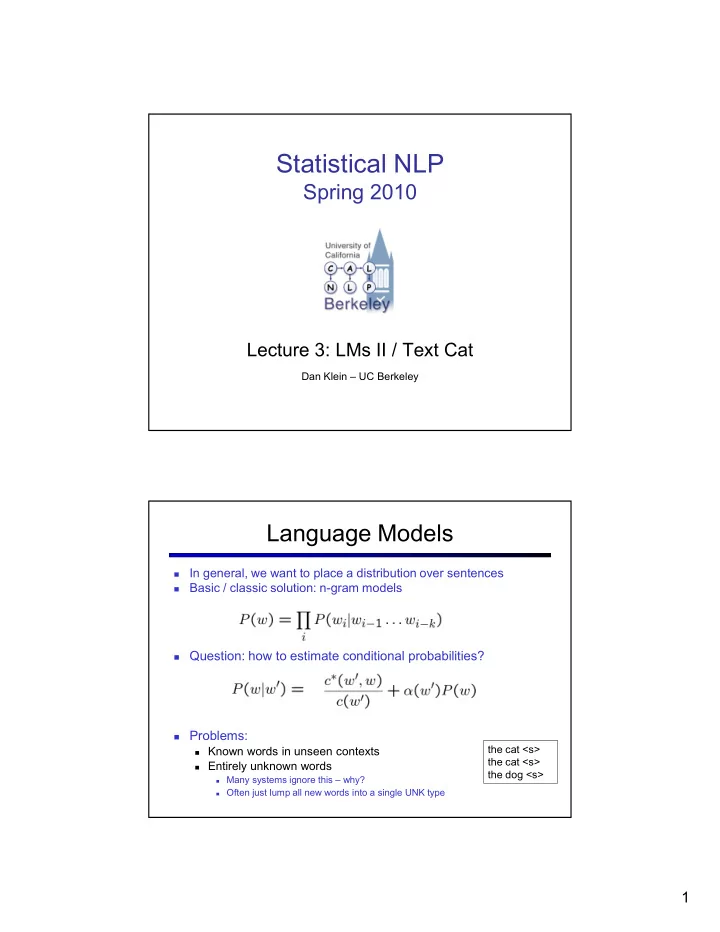

Statistical�NLP Spring�2010 Lecture�3:�LMs�II�/�Text�Cat Dan�Klein�– UC�Berkeley Language�Models In�general,�we�want�to�place�a�distribution�over�sentences � Basic�/�classic�solution:�n*gram�models � � Question:�how�to�estimate�conditional�probabilities? � Problems: the�cat�<s> � Known�words�in�unseen�contexts the�cat�<s> � Entirely�unknown�words the�dog�<s> � Many�systems�ignore�this�– why? � Often�just�lump�all�new�words�into�a�single�UNK�type 1
Held*Out�Reweighting � What’s�wrong�with�add*d�smoothing? � Let’s�look�at�some�real�bigram�counts�[Church�and�Gale�91]: Count�in�22M�Words Actual�c*�(Next�22M) Add*one’s�c* Add*0.0000027’s�c* 1 0.448 2/7e*10 ~1 2 1.25 3/7e*10 ~2 3 2.24 4/7e*10 ~3 4 3.23 5/7e*10 ~4 5 4.21 6/7e*10 ~5 Mass�on�New� 9.2% ~100% 9.2% Ratio�of�2/1 2.8 1.5 ~2 � Big�things�to�notice: � Add*one�vastly�overestimates�the�fraction�of�new�bigrams � Add*anything�vastly�underestimates�the�ratio�2*/1* � One�solution:�use�held*out�data�to�predict�the�map�of�c�to�c* Good*Turing�Reweighting�I “Training” “Held*Out” � We’d�like�to�not�need�held*out�data�(why?) � Idea:�leave*one*out�validation � N k :�number�of�types�which�occur�k�times�in�the� N 1 /N 0 entire�corpus � Take�each�of�the�c�tokens�out�of�corpus�in�turn � c�“training”�sets�of�size�c*1,�“held*out”�of�size�1 2N 2 /N 1 � How�many�“held*out”�tokens�are�unseen�in� “training”?� � N 1 3N 3 /N 2 � How�many�held*out�tokens�are�seen�k�times�in� training? � (k+1)N k+1 .�.�.�. .�.�.�. � There�are�N k words�with�training�count�k � Each�should�occur�with�expected�count� � (k+1)N k+1 /N k � Each�should�occur�with�probability: /N 3510 3511�N 3511 � (k+1)N k+1 /(cN k ) /N 4416 4417�N 4417 2
Good*Turing�Reweighting�II Problem:�what�about�“the”?��(say�k=4417) � � For�small�k,�N k >�N k+1 � For�large�k,�too�jumpy,�zeros�wreck�estimates N 1 N 0 N 1 N 2 N 2 N 1 N 3 � Simple�Good*Turing�[Gale�and�Sampson]:� N 3 N 2 replace�empirical�N k with�a�best*fit�power�law� once�count�counts�get�unreliable .�.�.�. .�.�.�. N 1 N 3511 N 3510 N 2 N 4417 N 4416 Good*Turing�Reweighting�III � Hypothesis:�counts�of�k�should�be�k*�=�(k+1)N k+1 /N k Count�in�22M�Words Actual�c*�(Next�22M) GT’s�c* 1 0.448 0.446 2 1.25 1.26 3 2.24 2.24 4 3.23 3.24 Mass�on�New� 9.2% 9.2% � Katz�Smoothing � Use�GT�discounted� ������� counts�(roughly�– Katz�left�large�counts�alone) � Whatever�mass�is�left�goes�to�empirical�unigram 3
Kneser*Ney:�Discounting Kneser*Ney smoothing:�very�successful�estimator�using�two�ideas � Idea�1:�observed�n*grams�occur�more�in�training�than�they�will�later: � Count�in�22M�Words Avg�in�Next�22M Good*Turing�c* 1 0.448 0.446 2 1.25 1.26 3 2.24 2.24 4 3.23 3.24 Absolute�Discounting � Save�ourselves�some�time�and�just�subtract�0.75�(or�some�d) � Maybe�have�a�separate�value�of�d�for�very�low�counts � Kneser*Ney:�Continuation � Idea�2:�Type*based�fertility�rather�than�token�counts � Shannon�game:��There�was�an�unexpected�____? � delay? � Francisco? � “Francisco”�is�more�common�than�“delay” � …�but�“Francisco”�always�follows�“San” � …�so�it’s�less�“fertile” � Solution:�type*continuation�probabilities � In�the�back*off�model,�we�don’t�want�the�probability�of�w�as�a�unigram � Instead,�want�the�probability�that�w�is� ������� �� ��������������� � For�each�word,�count�the�number�of�bigram�types�it�completes 4
Kneser*Ney � Kneser*Ney smoothing�combines�these�two�ideas � Absolute�discounting � Lower�order�continuation�probabilities � KN�smoothing�repeatedly�proven�effective�(ASR,�MT,�…) � [Teh,�2006]�shows�KN�smoothing�is�a�kind�of�approximate� inference�in�a�hierarchical�Pitman*Yor process�(and�better� approximations�are�superior�to�basic�KN) What�Actually�Works? � Trigrams�and�beyond: � Unigrams,�bigrams� generally�useless � Trigrams�much�better�(when� there’s�enough�data) � 4*,�5*grams�really�useful�in� MT,�but�not�so�much�for� speech � Discounting � Absolute�discounting,�Good* Turing,�held*out�estimation,� Witten*Bell � Context�counting � Kneser*Ney�construction� oflower*order�models [Graphs�from Joshua�Goodman] � See�[Chen+Goodman]� reading�for�tons�of�graphs! 5
Data�>>�Method? � Having�more�data�is�better… 10 9.5 100,000�Katz 9 100,000�KN 8.5 1,000,000�Katz ������� 8 1,000,000�KN 7.5 10,000,000�Katz 7 10,000,000�KN 6.5 all�Katz 6 all�KN 5.5 1 2 3 4 5 6 7 8 9 10 20 ������������ � …�but�so�is�using�a�better�estimator � Another�issue:�N�>�3�has�huge�costs�in�speech�recognizers Tons�of�Data? [Brants et�al,�2007] 6
Large�Scale�Methods Language�models�get�big,�fast � � English�Gigawords corpus:�2G�tokens,�0.3G�trigrams,�1.2G�5*grams � Need�to�access�entries�very�often,�ideally�in�memory What�do�you�do�when�language�models�get�too�big? � � Distributing�LMs�across�machines � Quantizing�probabilities � Random�hashing�(e.g.�Bloom�filters) [Talbot�and�Osborne�07] Beyond�N*Gram�LMs Lots�of�ideas�we�won’t�have�time�to�discuss: � � Caching�models:�recent�words�more�likely�to�appear�again � Trigger�models:�recent�words�trigger�other�words � Topic�models � A�few�recent�ideas � Syntactic�models:�use�tree�models�to�capture�long*distance� syntactic�effects�[Chelba and�Jelinek,�98] � Discriminative�models:�set�n*gram�weights�to�improve�final�task� accuracy�rather�than�fit�training�set�density�[Roark,�05,�for�ASR;�� Liang et.�al.,�06,�for�MT] � Structural�zeros:�some�n*grams�are�syntactically�forbidden,�keep� estimates�at�zero�if�the�look�like�real�zeros�[Mohri and�Roark,�06] � Bayesian�document�and�IR�models�[Daume 06] 7
Overview � So�far:�language�models�give�P(s) � Help�model�fluency�for�various�noisy*channel�processes�(MT,� ASR,�etc.) � N*gram�models�don’t�represent�any�deep�variables�involved�in� language�structure�or�meaning � Usually�we�want�to�know�something�about�the�input�other�than� how�likely�it�is�(syntax,�semantics,�topic,�etc) � Next:�Naïve*Bayes�models � We�introduce�a�single�new�global�variable � Still�a�very�simplistic�model�family � Lets�us�model�hidden�properties�of�text,�but�only�very�non*local� ones… � In�particular,�we�can�only�model�properties�which�are�largely� invariant�to�word�order�(like�topic) Text�Categorization Want�to�classify�documents�into�broad�semantic�topics�(e.g.�politics,� � sports,�etc.) Obama�is�hoping�to�rally�support� California�will�open�the�2009� for�his�$825�billion�stimulus� season�at�home�against� package�on�the�eve�of�a�crucial� Maryland�Sept.�5�and�will�play�a� House�vote.�Republicans�have� total�of�six�games�in�Memorial� expressed�reservations�about�the� Stadium�in�the�final�football� proposal,�calling�for�more�tax� schedule�announced�by�the� cuts�and�less�spending.�GOP� Pacific*10�Conference�Friday.� representatives�seemed�doubtful� The�original�schedule�called�for� that�any�deals�would�be�made. 12�games�over�12�weekends.� Which�one�is�the�politics�document?�(And�how�much�deep� � processing�did�that�decision�take?) One�approach:�bag*of*words�and�Naïve*Bayes�models � Another�approach�later… � Usually�begin�with�a�labeled�corpus�containing�examples�of�each� � class 8
Recommend
More recommend